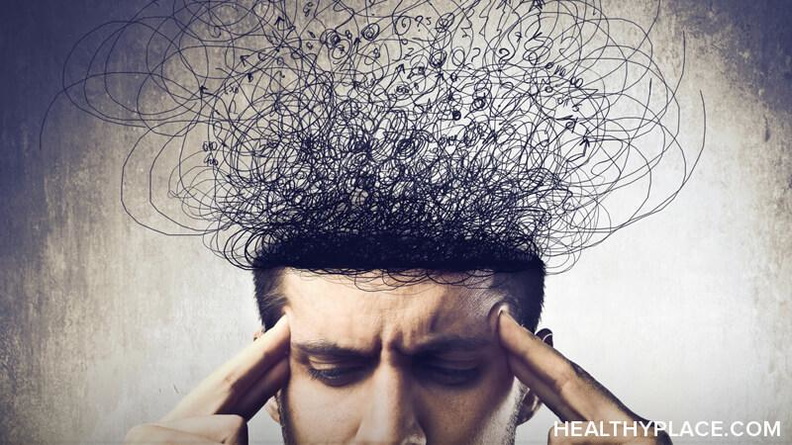Mental Illness: An Overview

Detailed explanation of mental illness and what severe mental illnesses are and aren't. Overview of depression, anxiety, schizophrenia and substance abuse.
Just the Thought of "Mental Illness" Is Scary for Many
When people hear the phrase "mental illnesses," often they will conjure up the images of a person tortured by the demons only he or she sees, or by the voices no one else hears. Or they may think of a benign, foolish person who, like Jimmy Stewart's character in "Harvey," talks to nonexistent friends.
This, of course, is the version of mental illnesses that most of us have developed from movies and literature. Films and books trying to create dramatic effect often rely on the extraordinary symptoms of psychotic illnesses like schizophrenia, or they draw on outmoded descriptions of mental illnesses that were evolved during a time when no one had any idea what caused them. Few who have seen these characterizations ever realize that people suffering even from the most severe mental illnesses actually are in touch with reality as often as they are disabled by their illnesses.
Moreover, few mental illnesses have hallucinations as symptoms. For example, most people suffering from a phobia do not have hallucinations or delusions, nor do those with obsessive-compulsive disorder. Most people with depression aren't so seriously ill that they act on bizarre sensory perceptions or thought processes. The unrelenting hopelessness, helplessness and suicidal thoughts of depression, the despair brought by alcoholism or drug abuse, may be hard to comprehend, but these are real, painful emotions, not hallucinations or delusions.
These widespread assumptions about mental illnesses also overlook one other important reality: as many as eight in ten people suffering from mental illnesses can effectively return to normal, productive lives if they receive appropriate treatment--treatment which is readily available. Psychiatrists and other mental health professionals can offer their patients a wide variety of effective treatments.
It is vital that Americans know that this help is available, because anyone, no matter what age, economic status or race, can develop a mental illness. During any one-year period, up to 50 million Americans -- more than 22 percent -suffer from a clearly diagnosable mental disorder involving a degree of incapacity that interferes with employment, attendance at school or daily life.
- 20 percent of the ailments for which Americans seek a doctor's care are related to anxiety disorders, such as panic attacks, that interfere with their ability to live normal lives.
- Some 8 million to 14 million Americans suffer from depression each year. As many as one in five Americans will suffer at least one episode of major depression during their lifetimes.
- About 12 million children under 18 suffer from mental disorders such as autism, depression and hyperactivity.
- Two million Americans suffer from schizophrenic disorders and 300,000 new cases occur each year.
- 15.4 million American adults and 4.6 million adolescents experience serious alcohol-related problems, and another 12.5 million suffer from drug abuse or dependence.
- Nearly one-fourth of the elderly who are labeled as senile actually suffer some form of mental illness that can be effectively treated.
- Suicide is the third leading cause of death for people between the ages of 15 and 24.

Many with Mental Illness Go Untreated
People suffering from mental illnesses often do not recognize them for what they are. About 27 percent of those who seek medical care for physical problems actually suffer from troubled emotions.
Mental illnesses and substance abuse afflict both men and women. Studies by the U.S. Alcohol, Drug Abuse and Mental Health Administration indicate men are more likely to suffer from drug and alcohol abuse and personality disorders, while women are at higher risk of suffering from depression and anxiety disorders.
The personal and social costs that result from untreated mental disorders are considerable--similar to those for heart disease and cancer. According to estimates by the Substance Abuse and Mental Health Services Administration (SAMHSA), Institute of Medicine, the direct costs for support and medical treatment of mental illnesses total $55.4 billion a year; the direct costs of substance abuse disorders come to $11.4 billion a year; and indirect costs such as lost employment, reduced productivity, criminal activity, vehicular accidents and social welfare programs increase the total cost of mental and substance abuse disorders to more than $273 billion a year.
Emotional and mental disorders can be treated or controlled, but only one in five people who have these disorders seek help, and only four to 15 percent of the children suffering severe mental illnesses receive appropriate treatment. This unfortunate reality is further complicated by the fact that most health insurance policies provide limited mental health and substance abuse coverage, if any at all.
Medications relieve acute symptoms of schizophrenia in 80 percent of cases, but only about half of all people with schizophrenia seek treatment. Fewer than one-fourth of those suffering from anxiety disorders seek treatment, even though psychotherapy, behavior therapy and some medications effectively treat these illnesses. Fewer than one-third of those with depressive disorders seek treatment. Yet, with therapy, 80 to 90 percent of the people suffering from these diseases can get better.
Advances in Diagnosis and Treatment of Mental Illness
Researchers have made tremendous progress in pinpointing the physical and psychological origins of mental illnesses and substance abuse.
- Scientists are now certain that some disorders are caused by imbalances in neurotransmitters, the chemicals in the brain that carry messages between nerve cells. Studies have linked abnormal levels of these neurotransmitters with depression and schizophrenia.
- A special technology called positron emission tomography (PET) has allowed psychiatric medical researchers to "watch" the living brain's functioning. Researchers have used PET to show that the brains of people suffering from schizophrenia do not metabolize the sugar called glucose in the same way as the brains of healthy people. PET also helps physicians determine if a person suffers from schizophrenia or the manic phase of bipolar disorder, which can have similar symptoms.
- Refinements of lithium carbonate, used in treating bipolar disorder, have led to an estimated annual savings of $8 billion in treatment costs and lost productivity associated with bipolar disorder.
- Medications are helpful in treating and preventing panic attacks among patients suffering severe anxiety disorders. Studies also indicate that panic disorders could be caused by some underlying physical, biochemical imbalance.
- Studies of psychotherapy by the National Institute of Mental Health have shown it to be very effective in treating mild-to-moderate depression.
- Scientists are beginning to understand the biochemical reactions in the brain that induce the severe craving experienced by cocaine users. Through this knowledge, new medications may be developed to break the cycle of cocaine craving and use.
Although these findings require continued research, they offer hope that many mental disorders may one day be prevented.

What Is Depression?
Depression is the most commonly diagnosed emotional problem. Almost one-fourth of all Americans suffer from depression at some point in life, and four percent of the population have symptoms of depression at any given time.
The term "depression" can be confusing since it's often used to describe a very normal emotion that passes quickly. Everyone feels "blue" or sad occasionally. But if that emotion continues for long periods, and if it is accompanied by feelings of guilt and hopelessness, it could be an indication of depression. The persistence and severity of such emotions distinguish the mental disorder of depression from normal mood changes.
People who suffer serious depression say they feel their lives are pointless. They feel slowed down, "burned out" and useless. Some even lack the energy to move or to eat. They doubt their own abilities and often look on sleep as an escape from life. Many think about suicide, a form of escape from which there is obviously no return.
Other symptoms that characterize depression are sleeplessness, loss of self-esteem, inability to feel pleasure in formerly interesting activities, loss of sexual drive, social withdrawal, apathy and fatigue.
Depression can be a response to stress from a job change, loss of a loved one, even pressures of everyday living. Sometimes it just happens, with no external cause. The problem can be debilitating, but it is not insurmountable and no one should have to suffer its symptoms. With treatment, people with depression can recover and lead full lives.
Some persons suffer from bipolar disorder, an illness in which sufferers' mood may swing from depression to an abnormal elation or mania that is characterized by hyperactivity, scattered ideas, distractibility, and recklessness. Most people suffering from bipolar disorder respond remarkably well to the mineral salt lithium, which seems to even out the disorder's terrible highs and lows.
Psychiatrists have a number of effective treatments for depression -- usually involving a combination of psychotherapy and antidepressant medications. Psychotherapy, a common form of treatment for depression, addresses specific emotional responses that contribute to a person's depression. The discovery of such emotional triggers allows persons to change their environment or their emotional reactions to it, thereby alleviating the symptoms. Psychiatrists have a full range of antidepressant medications which they often use to augment psychotherapy for treating depression.
Almost all depressed patients respond to psychotherapy, medication, or a combination of these treatments. Some depressed patients cannot take antidepressant medications, however, or may experience a depression so profound that it resists medication. Others may be at immediate risk of suicide, and with these patients the medications may not act quickly enough. Fortunately, psychiatrists can help these patients with electroconvulsive therapy (ECT), a safe and effective treatment for some serious mental disorders. In this treatment, the patient receives a short-acting general anesthetic and a muscle relaxant followed by a painless electric current administered for less than a second through contacts placed on the head. Many patients report significant improvement in their mood after only a few ECT treatments.

Anxiety Disorders Overview: Excessive Fear, Worry and Panic Attacks
Fear is a safety valve that helps us recognize and avoid danger. It increases our reflexive responses and sharpens awareness.
But when a person's fear becomes an irrational, pervasive terror or a nagging worry or dread that interferes with daily life, he or she may be suffering from some form of anxiety disorder. This affliction affects about 30 million Americans, including 11 percent of the population who suffer serious anxiety symptoms related to physical illness. In fact, anxiety is thought to contribute to or cause 20 percent of all medical conditions among Americans seeking general health care.
There are many different expressions of excessive anxiety. Phobic disorders, for example, are irrational, terrifying fears about a specific object, social situations or public places. Psychiatrists divide phobic disorders into several different classifications, most notably specific phobias, social phobias and agoraphobia.
Specific phobias are a relatively common problem among Americans. As this category's name implies, people suffering from specific phobia generally have irrational fear of specific objects. If the feared object rarely appears in the person's life, the phobia may not create serious disability. If the object is common, however, the resulting disability can be severe. The most common specific phobia in the general population is fear of animals -- particularly dogs, snakes, insects and mice. Other specific phobias are claustrophobia (fear of enclosed spaces) and acrophobia (fear of heights). Most specific phobias develop during childhood and eventually disappear. But those that persist into adulthood rarely go away without treatment.
Social phobia is the irrational fear and avoidance of being in a situation in which a person's activities can be watched by others. In a sense, it is a form of "performance anxiety," but a social phobia causes symptoms that go well beyond the normal nervousness before an on-stage appearance. People suffering social phobias intensely fear being watched or humiliated while doing something--such as signing a personal check, drinking a cup of coffee, buttoning a coat or eating a meal--in front of others. Many patients suffer a generalized form of social phobia, in which they fear and avoid most interactions with other people. This makes it difficult for them to go to work or school, or to socialize at all. Social phobias occur equally among men and women, generally developing after puberty and peaking after age 30. A person can suffer from one or a cluster of social phobias.
Derived from the Greek, agoraphobia literally means "fear of the marketplace." This disorder, which afflicts twice as many women as men, is the most serious of the phobic disorders. It causes its victims to fear being alone in any place or situation from which he or she thinks escape would be difficult or help unavailable if he or she were incapacitated. People with agoraphobia avoid streets, crowded stores, churches, theaters and other crowded places. Normal activities are restricted by this avoidance, and people with the disorder often become so disabled they literally will not leave their homes. If people with agoraphobia do venture into phobic situations, they do so only with great distress or when accompanied by a friend or family member.
Most people with agoraphobia develop the disorder after first suffering a series of one or more spontaneous panic attacks. The attacks seem to occur randomly and without warning, making it impossible for a person to predict what situations will trigger the reaction. The unpredictability of the panic attacks "trains'' the victims to anticipate future panic attacks and, therefore, to fear any situation in which an attack may occur. As a result, they avoid going into any place or situation where previous panic attacks have occurred.
Agoraphobia victims also may develop depression, fatigue, tension, alcohol or drug abuse problems and obsessive disorders.
These conditions are treatable with psychotherapy and with medication. Psychiatrists and other mental health professionals use desensitization techniques to help people with phobic disorders. They teach patients deep muscle relaxation techniques, and work to understand what provoked the anxiety. They rely on relaxation techniques to quell patients' fear. As the sessions progress, the object or situation that provokes the fear no longer has its hold on the person.
Panic disorder, while it often accompanies phobias such as agoraphobia, can occur alone. People with panic disorder feel sudden, intense apprehension, fear or terror, that can be accompanied by heart palpitations, chest pain, choking or smothering sensations, dizziness, hot and cold flashes, trembling and faintness. These "panic attacks,'' which are the disorder's main feature, usually begin during adolescence or early adult life. Many people experience panic disorder's symptoms at some time in their lives as a "panic attack," in episodes that are limited to a single brief period and that may be connected to stressful life events. But psychiatrists diagnose panic disorder when the condition has become chronic.
People with generalized anxiety disorder suffer with unrealistic or excessive anxiety and worry about life circumstances. For example, they may feel anxious about financial matters when there's plenty of money in the bank and their debts are paid. Or they may be preoccupied constantly about the welfare of a child who's safe at school. People with generalized anxiety disorder may have stretches of time when they're not consumed by these worries, but they are anxious most of the time. Patients with this disorder often feel "shaky," reporting that they feel "keyed up" or "on edge" and that they sometimes "go blank" because of the tension they feel. They often suffer also with mild depression.
The behaviors that are a part of obsessive-compulsive disorder include obsessions (which are recurring, persistent and involuntary thoughts or images) which often occur with compulsions (repetitive, ritualistic behaviors -- such as hand washing or lock checking -- which a person performs according to certain "rules"). The individual doesn't get pleasure from such behavior, and, in fact, recognizes that it is excessive and has no real purpose. Still, a person with OCD will claim they "can't help" their ritualistic behavior, and will become very anxious if it is interrupted. Often beginning in adolescence or early adulthood, obsessive and compulsive behaviors frequently become chronic.
Increasing evidence supports the theory that the disorders arise at least partly from imbalances in the brain's chemistry. Some investigators believe these disorders result from a traumatic experience in childhood that has been consciously forgotten, but surfaces as a reaction to a feared object or stressful life situation, while others believe they arise from imbalances in brain chemistry. Several forms of medication and psychotherapy are highly effective in treating anxiety disorders, and research continues into their causes.

What Is Schizophrenia?
Like depression, schizophrenia afflicts persons of all ages, races and economic levels. It affects up to two million Americans during any given year. Its symptoms frighten patients and their loved ones, and those with the disorder may begin to feel isolated as they cope with it.
The term schizophrenia refers to a group of disorders that have common characteristics, though their causes may differ. The hallmark of schizophrenia is a distorted thought pattern. The thoughts of people with Schizophrenia often seem to dart from subject to subject, often in an illogical way. Patients may think others are watching or plotting against them. Often, they lose their self-esteem or withdraw from those close to them.
The disease often affects the five senses. Persons suffering schizophrenia sometimes hear nonexistent sounds, voices or music or see nonexistent images. Because their perceptions do not fit reality, they react inappropriately to the world. In addition, the illness affects emotions. Patients react in an inappropriate manner or without any visible emotion at all.
Though the symptoms of schizophrenia can appear suddenly during times of great stress, schizophrenia most often develops gradually, and close friends or family might not notice the change in personality as the illness takes initial hold.
Theories about the causes of schizophrenia abound, but research has not yet pinpointed what causes the disease. In recent years, laboratory findings have suggested strongly that schizophrenia is passed on genetically from generation to generation. Scientist have theorized that the disease may be triggered, in some people with this inherited predisposition, by another illness that changes the body's chemistry, an unhappy or violent childhood, a highly stressful situation in adult life or a combination of these. Some think disturbances in brain chemistry or the hormonal system contribute to the disease's development. Some studies have found abnormal levels of some chemicals in the blood and urine of people with schizophrenia. One study has suggested that the alignment of cells in a particular area of the brain goes awry before birth.
Schizophrenia cannot be cured, but it can be controlled. Thanks to new treatments, most persons with schizophrenia are able to work, live with their families, and enjoy friends. Very few are ever violent or behave in unacceptable ways. But, like a person with diabetes, the person with schizophrenia probably will have to be under medical care for the rest of his or her life.
Researchers have found a number of antipsychotic medications that aid in the treatment of schizophrenia. Of course, these drugs should be used only under the close supervision of a psychiatrist.
Additionally, psychotherapy can offer understanding, reassurance, and careful insights and suggestions for handling the emotional aspects of the disorder. A change in the patient's living and working environment can reduce stressful situations. A combination of treatments should be tailored to the individual patient's needs.

Substance Abuse Overview
Substance abuse should be a part of any discussion about mental illnesses. Substance abuse -- the misuse of alcohol, cigarettes and both illegal and legal drugs -- is by far the predominant cause of premature and preventable illness, disability and death in our society. According to the National Institute of Mental Health, nearly 17 percent of the U.S. population 18 years old and over will fulfill criteria for alcohol or drug abuse in their lifetimes. When the effects on the families of abusers and people close to those injured or killed by intoxicated drivers are considered, such abuse affects untold millions more.
While abuse of and/or dependence on substances may in their own right bring suffering and physical sickness that require psychiatric medical treatment, they often accompany other seemingly unrelated mental illnesses as well. Many people who struggle with mental illnesses also struggle with alcohol or drug habits that may have begun in their mistaken belief that they can use the substance to "medicate" the painful feelings that accompany their mental illness. This belief is mistaken because substance abuse only adds to the suffering, bringing its own mental and physical anguish. Here, too, psychiatrists can offer hope with a number of effective treatment programs that can reach the substance abuser and his or her family.
Conclusion
People who experience emotional disorders such as those described in this brochure do not have to suffer without help. By consulting a psychiatrist, they make a positive step toward controlling and curing the condition that interferes with their lives. If you, a friend or family member is suffering from a mental illness, contact the psychiatric or medical society in your area, a local mental health center, or ask your general physician for names of a psychiatrist.
Don't be afraid to ask for help. It's a sign of strength.
(c) Copyright 1988, 1990 American Psychiatric Association
Revised 1994
Produced by the APA Joint Commission on Public Affairs and the Division of Public Affairs. This document contains the text of a pamphlet developed for educational purposes and does not necessarily reflect opinion or policy of the American Psychiatric Association.
Additional Resources
Ablow, K. Anatomy of A Psychiatric Illness: Healing the Mind and the Brain. Washington, DC: American Psychiatric Press, Inc., 1993.
Brown, George W. and Harris, Tirril O., Eds. Life Events and Illness. New York: Guilford Press, 1989.
Copeland, M. The Depression Workbook. New Harbinger, 1992.
Gaw, A., Ed. Culture, Ethnicity, and Mental Illness. Washington, DC: American Psychiatric Press, Inc., 1992.
Fink, Paul and Tasman, Allan, Eds. Stigma and Mental Illness. Washington, DC: American Psychiatric Press, Inc., 1991.
Lickey, Marvin and Gordon, Barbara. Medicine and Mental Illness: Understanding Drug Treatment in Psychiatry. New York, NY: Freeman and Co., 1991.
McElroy, E., Ed. Children and Adolescents with Mental Illness: A Parents Guide. Kensington, MD: Woodbine House, 1988.
Roth, M. and Kroll, J. The Reality of Mental Illness. New York, NY: Cambridge University Press, 1986.
Here are some resources you can contact for more information or assistance:
American Academy of Child and Adolescent Psychiatry
(202) 966-7300
National Alliance for the Mentally Ill (NAMI)
(703) 524-7600
National Depressive and Manic-Depressive Association (NDMDA)
1-800/82-NDMDA
National Institute of Mental Health (NIMH)
(301) 443-4513
National Mental Health Association
(703) 684-7722
APA Reference
Staff, H.
(2009, January 3). Mental Illness: An Overview, HealthyPlace. Retrieved
on 2026, January 3 from https://www.healthyplace.com/other-info/psychiatric-disorder-definitions/mental-illness-an-overview


